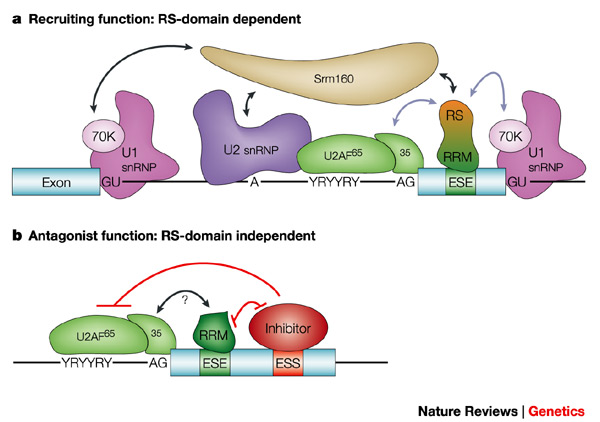

 |
|
 |
|
|
|
A typical mammalian gene is composed of several relatively short exons that are interrupted by much longer introns. To generate correct mature mRNAs, the exons must be identified and joined together precisely and efficiently, in a process that requires the coordinated action of five small nuclear (sn)RNAs (U1, U2, U4, U5 and U6) and more than 60 polypeptides. The inaccurate recognition of exon/intron boundaries or the failure to remove an intron generates aberrant mRNAs that are either unstable or code for defective or deleterious protein isoforms. Paradoxically, in higher eukaryotes, the requirement for accurate splicing is met by exon-intron junctions that are defined by weakly conserved intronic cis-elements: the 5' splice site, 3' splice site and branch site. These elements are necessary but by no means sufficient to define exon/intron boundaries. Several examples of intronic and exonic cis-elements that are important for correct splice-site identification and are distinct from the classical splicing signals have been described. These elements can act both by stimulating (enhancers) or by repressing (silencers) splicing, and they seem to be especially relevant for regulating alternative splicing. Exonic splicing enhancers (ESEs), in particular, appear to be very prevalent, and may be present in most, if not all exons, including constitutive ones Exonic enhancers are thought to serve as binding sites for specific serine/arginine-rich (SR) proteins, a family of structurally related and highly conserved splicing factors characterized by one or two RNA-recognition motifs (RRM) and by a distinctive C-terminal domain highly enriched in RS dipeptides (the RS domain). The RRMs mediate sequence-specific binding to the RNA, and so determine substrate specificity, whereas the RS domain appears to be involved mainly in protein-protein interactions. SR proteins bound to ESEs can promote exon definition by directly recruiting the splicing machinery through their RS domain and/or by antagonizing the action of nearby silencer elements. |
 |
|
a) RS-domain-dependent mechanism. An SR
protein
binds to an ESE through its RRMs and contacts the splicing
factor U2AF35 and/or the snRNP protein U1-70K at the adjacent
splice sites through its RS domain. The large subunit of U2AF
(U2AF65) binds to the polypyrimidine (Y) tract, which here is
interrupted by purines (R) and is therefore part of a weak 3'
splice site. U2AF65 also promotes binding of U2 snRNP to the
branch site. U2AF35 recognizes the 3' splice-site AG dinucleotide.
The U1 snRNP particle binds to the upstream and downstream 5'
splice sites through base paring of the U1 snRNA; the 70K
polypeptide
of each U1 snRNP particle is shown. The three sets
of splicing-factor:pre-mRNA
interactions (U2AF:3' splice site,
U1 snRNP:5' splice site and
SR protein:ESE) are strengthened by
the protein:protein interactions
(blue arrows) that are
mediated by the RS domain. For some ESE-dependent
pre-mRNAs,
indirect interactions (black arrows) are bridged by
the
splicing co-activator Srm160, which stimulates splicing of
some
ESE-dependent pre-mRNAs and also interacts with the U2 snRNP.
|
|
Cartegni L., Chew S.L., & Krainer A.R.
Listening
to silence and understanding nonsense: exonic mutations that
affect splicing. Nat Rev Genet. 2002 3(4),285-98.
|
|
|
|
|
Krainer's lab page Zhang's lab page |
 |